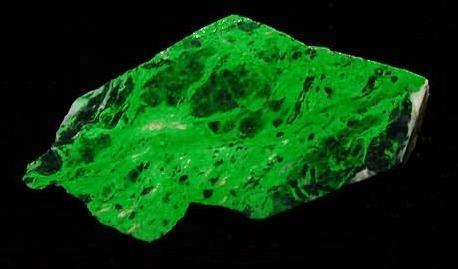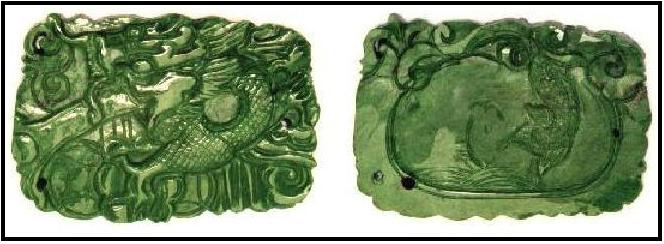
MAW-SIT-SIT


A. Maw-sit-sit rough (width - ca.12.5 cm). Unconventional Lapidarist. (© photo by Cindy Fowler, courtesy www.unconventionallapidarist.com)
B. Maw-sit-sit
carving (width - 45
mm) for brooch; front and rear views of a sample
studied by F.Colombo, C.Rinaudo and C.Trossarelli (2000). Sig. Scardina, jeweler of Turin,
Italy collection.
(© photo by C.Trossarelli, courtesy of Caterina
Rinaudo)
DESCRIPTION: A metamorphic rock that has been
recorded diversely as consisting of 1."albite that is
irregularly interspersed with an alien,chromiferous mineral that
induces the brilliant green color" (Gubelin, 1964-65) -- note use of
singular nouns referring to the non-albite portion; 2.six
chief constituents -- kosmochlor, chrome-jadeite, chrome
amphibole, chromite, "symplektite" and a matrix of lighter colored
minerals "(Zeolite, Chlorite, Albite, Serpentine) which fills the space
between the minerals" (Hanni and Meyer, 1997); 3.albite,
chromian-eckermannite, kosmochlor, chromite and natrolite
(Colombo, Rinaudo and Trossarelli, 2000); [and]
4.kosmochlor [62 to ~65 per cent], chrome-jadeite [15 to ~18 per cent],
chromian eckermannite [~4 per cent], chromiferous-albite [~1 per cent],
plus chromite, etc. (Qi, et al., 2003). (Two things for the record:
A.ureyite is listed as a constituent in a couple reports, instead
of kosmochlor, which is the designation currently accepted by
the International
Mineralogical
Association Commission on New Minerals and Mineral Names ; [and]
B.symplektite is described by Hanni and Meyer (ibid.)
as "a
very fine
mineral mixture which cannot be resolved microscopically.").
In addition, it seems
only prudent to emphasize the fact that the relative percentages of the
constituents of Maw-sit-sit may vary rather markedly within a rather
broad range so the appearance and properties, such as its specific
gravity, may
also vary fairly markedly, specimen to specimen.
Colors - diverse green hues, commonly
described as brilliant or vivid, typically mottled with black
and/or white spots and/or streaks
H. (effective) 6-7
(as noted elsewhere, effective hardness is based on the hardnesses of
the predominant constituents, which control checks used when the
"unknown" is used as the "scratcher" rather than the material being
scratched.)
S.G. 2.5-3.5.
Light transmission -
opaque with some thin slices subtranslucent
Luster -
ranges from
glassy to oily or porcelaneous
Breakage -
conchoidal to irregular.
OTHER NAMES: The designation Maw-sit-sit, used by people of the source area is apparently based on the name of the source locality in northernwestern Myanmar (previously Burma). Other previously applied names, none of which -- in my opinion -- should be applied, follow:
USES: Beads, buttons, cabochons, polished slabs and small carivings, some of which, especially in the past, have been marketed as jade substitutes or with names indicating them to be a kind of jade (see examples under the OTHER NAMES subheading.
OCCURRENCES: The occurrence as described by Gubelin (1964-65) indicate that weathering and water in the workings obscure the geological relationships so hypotheses of origina are based largely on mineralogical and petrological investigations. Two relatively recently suggested origins follow: “Maw Sit Sit was formed in connection with a high pressure low temperature rock metamorphosis which affected an ultrabasic body locally. New formations of minerals also took place after the culmination of the metamorphosis. Essentially it was a metasomatic reaction between serpentinites and albite dykes. ... The chromium which is found in most of the constituent minerals most probably stems from former chromite layers which have been dissolved during the metamorphic transitions. Remnants of chromite are sometimes found as relicts within the Kosmochlor spots. The Maw Sit Sit deposit is placed at the rim of a larger peridotite body which has been altered and serpentinized.” (Hanni & Meyer, 1997.) [and] "The jade is formed by the dynamic metamorphism and metasomatism characterized by mylonitic, metasomatic network and metasomatic pseudomorphous textures. . . . [i.e.,] by the superimposition and reformation of multistage dynamic metamorphism and low-temperature hydrothermal metasomatism." (Qi et al., 2003). In addition, Gubelin (op cit.) noted, by implication, that Maw-sit-sit boulders derived from the bedrock have been found in the Uru valley.
NOTEWORTHY LOCALITY: Mining area that is about a half a mile westnorthwest of Namshamawa, which is a small village in the Himalayan foothills of northwestern Myanmar (formerly Burma). This prime source is near the well-known Kansi and Namshawa imperial jadeite occurrences.
REMARKS: The designation
Maw-sit-sit -- which, as already noted, is the name used by natives who
mined and worked the material in
Burma
(now Myanmar) -- appears to have been introduced into the
so-called
Western World by the Swiss gemologist Eduard Gubelin who recorded his
visit
to the source area in two papers (1963 and 1964-65).
Subsequently, as also noted herein, he and Crowningshield
suggested alternative names, none of which has had noteworthy use in
lieu of Maw-sit-sit.
Indeed,
that fate for one of those terms was predicted: Gubelin (1965)
stated
that his alternative jade-albite, which he considered more appropriate
"does
not exclude the admission that the original native name Maw-sit-sit may
continue to be used in the future."
To date, I have found no record of treatments to enhance the appearance of Maw-sit-sit. Again, however, it seems prudent to mention the multimineral composition of Maw-sit-sit because it requires special procedures to keep the softer mineral parts from being abraded out and thus leading to undesireable irregularities on polished surfaces.
While compiling remarks
for the entries for the individual Gemrocks treated on this web site,
I early decided not to include most apparently recently
concocted curative, astrological (etc.)
attributes
suggested for many of these materials and things fashioned from
them; to me they seemed to have been been made up for the most
part merely to
increase sales -- i.e., to be marketplace ploys. When,
however, one of my long-time research associates came up with the
following "use" of Maw-sit-sit, I decided to repeat it here
(albeit with “tongue in cheek”!!): “Maw-sit-sit when powdered, mixed
with lac (or colorless fingernail polish)
and applied to the fourth toe of one’s foot on each Friday that occurs
on the thirteenth of a month, and the treatment is repeated over a
period of two years, will immunize the person from future bouts
of foot-in-the-mouth disease. There are, however, added
requirements -- 1.the powder must include at least some of both the
black and green parts of the Maw-sit-sit; 2.application is to be
on only the
fourth toe of the right foot of left-handed people and only the fourth
toe of the left foot of right-handed people; and
3.application must be after at least six hours fasting (e.g.,
before breakfast or even early morning coffee). ... This use has
been tested and found to have no ill effects, and compared to parallel
use of jade (as
a placebo), its application was found to be effective for more than 80
percent of those in the test group whereas use of the placebo showed no
positive results. ...” (R. Dirk Ttitamgim, personal communication,
2004)
The kosmochlor versus ureyite designations for the chromian clinopyroxene constituent of Maw-sit-sit seems noteworthy in case anyone may uses a piece fashioned from this gemrock as a conversation piece: So far as its occurrence in Maw-sit-sit, this mineral was first identified as ureyite (named for Harold Clayton Urey, Nobel lauriate - 1934 - because of his discovery of heavy hydrogen); later, however, ureyite was found to be mineralogically the same as kosmochlor (so-named -- cosmo-"space" and chlor-green color -- because it was first found and thought to occur only in meteorites; the kosmochlor designation, having precidence, is the accepted name for this mineral (i.e., as just mentioned, ureyite has been discreditedas a mineral name) -- see International Mineralogical Association Commission on New Minerals and Mineral Names: www.geo.vu.nl/users/ima-comm/IMA-list.pdf).
SIMULANTS:
Malachite
- Although suggested as a possibility, I know of no recorded use
or misrepresentation of malachite for Maw-sit-sit. - [If ever so
represented, malachite would be easy to distinguish from
Maw-sit-sit
by
visual observation because
of the characteristic green hues and banding of malachite; also,
the hardness of malachite is much less than the effective hardness of
Maw-sit-sit; etc.].
Jade -
Although some jade might be so-represented, this seems unlikely. - [If
it were so represented, visual observation should suffice so far as
distinguishing
virtually any jade from Maw-sit-sit.]
In my opinion, some of the simulants listed for jade (see THE JADES entry) would appear to be more likely simulants for Maw-sit-sit.
REFERENCES: No general reference.
R. V. Dietrich © 2015
Last
update: 16 June 2005
web page created by Emmett Mason